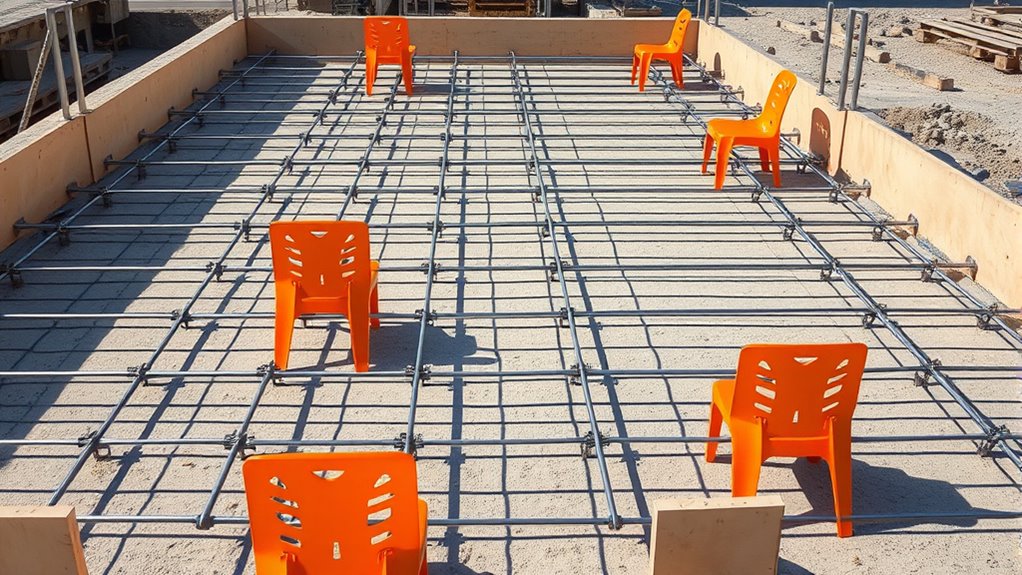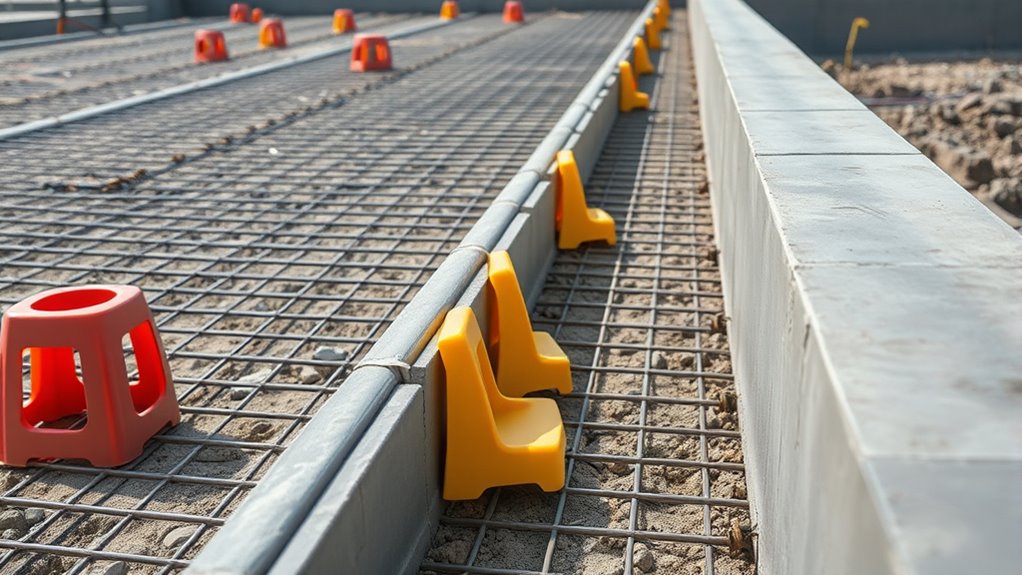Before pouring concrete, make certain your rebar is correctly placed, securely tied, and free from corrosion, following your plans exactly. Use the right chairs and supports to keep rebar at proper height and alignment, checking their stability and spacing. Confirm edge forms are level, plumb, and firmly secured to prevent shifting. Proper placement and stability of all components are key to a successful pour. Keep going for more tips to guarantee your project’s success.
Key Takeaways
- Verify rebar is correctly positioned according to plans, with proper overlaps and secure ties at all intersections.
- Ensure all rebar supports and chairs are properly placed, stable, and maintain correct height and spacing.
- Confirm edge forms are level, aligned, secured with stakes or braces, and free from movement or flexing.
- Double-check rebar for damage or corrosion, replacing or repairing as needed before pouring.
- Inspect all supports and ties to prevent shifting during concrete placement, ensuring stability and proper reinforcement.
Inspecting Rebar Placement and Tying

Have you double-checked that all rebar is correctly placed and securely tied? Make certain each piece is positioned according to your plans, with proper overlaps and spacing. Confirm that all ties are tight, preventing movement during pouring. Loose or improperly tied rebar can cause shifting, compromising the concrete’s strength. Use a rebar chair or support to maintain the correct height and alignment. Check for any signs of corrosion or damage to the rebar, replacing or repairing as needed. Make sure all rebar intersections are securely tied with appropriate wire. Verify that the rebar layout matches the structural drawings precisely. Taking these steps minimizes the risk of errors, ensuring the rebar functions correctly within the concrete, ultimately contributing to a solid, durable structure.
Ensuring Proper Use of Chairs and Supports

Are you confident that all chairs and supports are correctly positioned and stable before pouring concrete? Double-check that each support is placed at the right height to keep rebar at the proper level. Ensure supports are firmly anchored and won’t shift under the weight of the concrete. Verify that chairs are evenly spaced, typically no more than 2 feet apart, to prevent sagging or displacement. Look for any signs of instability, such as wobbling or loose supports, and tighten or reposition as needed. Proper placement helps maintain the structural integrity of your pour and prevents costly adjustments later. Take your time to confirm everything is secure, stable, and ready to go. A solid foundation with supports ensures a successful pour and durable finished product. Additionally, understanding sound vibrations can help you appreciate how proper support placement minimizes unwanted movements and vibrations during the pour process.
Verifying Edge Form Alignment and Stability

To guarantee a smooth concrete pour, you need to verify that the edge forms are properly aligned and stable. Check that forms follow the design lines and are level in both directions. Use a string line or laser level for accuracy, and ensure the forms are firmly supported with stakes or braces. Confirm they are plumb and free of flexing or shifting. Properly aligned forms prevent uneven edges and reduce rework. Here’s a quick reference:
| Aspect | What to Check |
|---|---|
| Alignment | Follow design lines, use level or laser level |
| Stability | Secure with stakes, braces, ensure no movement |
Taking these steps ensures your concrete edges will be clean, straight, and ready for finishing. Additionally, form stability is essential to withstand the weight of the wet concrete without shifting.
Frequently Asked Questions
How Do I Identify Potential Rebar Corrosion Issues Before Pouring?
You should inspect the rebar for signs of corrosion, such as rust, discoloration, or flaky surfaces. Use a wire brush to clean any rust spots and check for pitting or scaling. Confirm that the rebar is properly coated or protected, especially if exposed to moisture or chlorides. Regularly monitor the environment and rebar condition before pouring, and address any issues to prevent future corrosion problems.
What Are Common Mistakes to Avoid When Placing Chairs?
You should avoid placing chairs too high or unevenly, as this can lead to unstable rebar support. Verify they are tightly secured and properly spaced to prevent shifting during pouring. Don’t forget to check that chairs do not touch the ground or form surfaces, which can cause corrosion. Also, avoid using damaged or incompatible chairs that could compromise the reinforcement’s integrity. Proper placement guarantees a strong, durable concrete structure.
How Can I Ensure Edge Forms Are Resistant to Concrete Pressure?
To guarantee edge forms resist concrete pressure, you should securely fasten them with stakes or ties, preventing movement during pouring. Use sturdy, properly aligned forms and double-check their integrity before pouring. Reinforce the edges with additional bracing if needed, and make sure the forms are clean and free of debris. Regularly inspect the setup during the pour, so you can promptly address any signs of shifting or damage.
What Tools Are Recommended for Inspecting Rebar Tie Quality?
You should use a rebar inspection mirror and a flashlight to check the tie quality thoroughly. A torque wrench helps guarantee ties are tightened to the correct specifications. For more precision, consider a rebar spacing gauge to verify proper placement. Hand-held pliers or rebar tie tools make tightening easier and more consistent. Regularly inspect for loose or broken ties, ensuring all rebar connections are secure before pouring concrete.
How Do Environmental Conditions Affect Pre-Pour Checklist Procedures?
Environmental conditions like rain, wind, and temperature fluctuations markedly impact your pre-pour checklist procedures. You need to verify that rebar and formwork are dry and free of debris, especially in wet weather, to guarantee proper bonding. Cold temperatures can delay setting times, so you might need to adjust your schedule or use heating methods. Wind can cause instability, so securing forms and rebar tightly is essential for safety and quality.
Conclusion
Think of your pre-pour checklist as the blueprint for a sturdy bridge. When you carefully inspect rebar placement, guarantee chairs are secure, and edge forms are aligned, you’re laying the foundation for a solid pour. Skipping these steps is like building on shaky ground. Stay vigilant, double-check everything, and you’ll create a structure that stands tall and true, just like a well-constructed bridge that endures the test of time.









